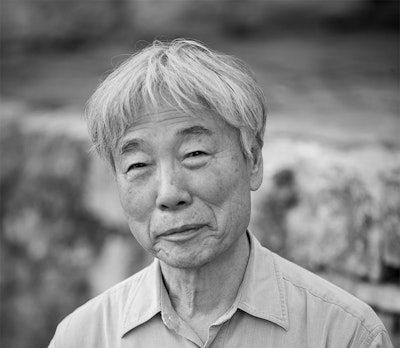
Lee Ufan
Lee Ufan, (Corea del sud, 1936)
Lee Ufan nasce nel 1936 a Kyongnam, Corea del Sud. Nel 1961 si laurea in filosofia presso la Nihon University, Tokyo. Attualmente vive e lavora tra Giappone e Francia. Lee Ufan è riconosciuto a livello internazionale come il maggior esponente del movimento giapponese Mono-ha, che sul finire degli anni ’60 propone una pratica artistica dedita all’esplorazione sistematica dei materiali naturali e industriali e del loro rapporto con lo spazio. Nelle sperimentazioni Mono-ha l’arte si emancipa dal sistema di rappresentazione e finzione per entrare nel vivo dei processi. Lee Ufan realizza sculture utilizzando quasi esclusivamente pietra e acciaio. A partire dagli anni ’60 inaugura la serie Relatum, il cui titolo si rifà al termine filosofico che denota cose o eventi tra cui esiste una relazione. Per la serie Dialogue, l’artista colloca le tele sul pavimento, segnando la superficie bianca con una pennellata di colore a olio misto a pigmento minerale. I dipinti sono caratterizzati da spazi vuoti, dovuti alla decisione di lasciare zone incomplete: l’assenza e il vuoto hanno grande spazio nella sua poetica e nei suoi lavori. Nell’approccio artistico di Lee Ufan non c’è spazio per l’oggetto in sé, ma piuttosto per la relazione che si origina tra le cose, e la visione estetica si traduce per lo spettatore nel fare esperienza del tempo e dello spazio.
Recenti mostre personali dell’artista sono state quelle presso Lisson Gallery, London (2015), Palazzo Contarini Polignac, Venezia (2015) e Château de Versailles, Francia (2014). I suoi lavori sono stati esposti a Punta della Dogana in occasione della mostra “Prima Materia” (2013-15) e a Palazzo Grassi per “Il mondo vi appartiene” (2011-12).
English
Lee Ufan was born in 1936 in a rural village in Korea under Japanese colonial rule. His early years were marked by a strict Confucian upbringing where he was tutored in East Asian brushwork. The disciplined, repetitive act of drawing points and lines—the foundation of the Chinese classical arts—would be particularly influential on his art practice later in life. In 1956 Lee attended Seoul National University College of Fine Arts and in 1958 transferred to Tokyo's Nihon University to study philosophy and aesthetics.
Lee rose to prominence in the late 1960s as the leading theorist and practitioner of Mono-ha, a Japanese art movement that grew out of the anti-authoritarian and anti-colonialist tumult of the postwar period. It emphasized the use of raw physical materials left to scatter, lean, drop, or break according to their situation. Applying structuralism, phenomenology, and Asian metaphysics in dialogue with international Post-Minimalist practices, Arte Povera, Nouveau Réalisme, and Land art, he developed a radical artistic language revolving around the notion of encounter—seeing the bare existence of what is actually before us and focusing on "the world as it is."
Lee's sculptural works from this period, which he refers as kōzō, or "living structures," are distinguished by a move away from expression and toward a detached act of arranging or mediating. These works are often titled Relatum (1968–), a Latin term denoting "relation," and operate in an expanded field where the artist's creative gesture resides in the choreographed confluence of the object, the viewer, and the resonant surrounding space. Similarly, his paintings incorporate vast areas of white space that function as a productive site of possibility rather than a void or negative space.
In the early 1970s, Lee received significant attention at Tokyo's leading galleries and museums and began exhibiting in West Germany and France, including at the 1971 Paris Youth Biennale, which introduced Mono-ha to Europe and led him to establish a studio in Paris that year. In the wake of Abstract Expressionism in the United States and Art Informel in Europe, Lee developed the iconic From Point and From Line series (1972–84). Here Lee employed a monochrome palette and iterative brush strokes moving horizontally or vertically across the canvas to chart the passage of lived time. This body of work garnered critical acclaim in Asia and became especially influential in his home country of Korea, where he became a seminal figure in the tansaekhwa (monochrome painting) school.
Lee has been the subject of major exhibitions at the National Museum of Contemporary Art, Seoul (1994); the Galerie Nationale du Jeu de Paume, Paris (1997); Kunstmuseum Bonn (2001); the Samsung Museum of Modern Art, Seoul (2003); the Musée d'Art Moderne de Saint-Etienne Métropole (2005); the Yokohama Museum of Art (2005); the 52nd Venice Biennale (2007); and the Royal Museums of Fine Arts of Belgium, Brussels (2009). In 2011 Lee's work was featured at two venues at the 54th Venice Biennale. Lee has matched his artistic output with a prodigious body of critical writings and is the author of 17 books, including the English-language anthology The Art of Encounter (2007). He was awarded the UNESCO Prize in 2000 and the Praemium Imperiale for painting in 2001. During the 1990s, Lee was a visiting professor at the École Nationale Supérieure des Beaux-Arts in Paris, and he served as professor of art at Tama Art University in Tokyo from 1973 to 2007. In 2010 the Lee Ufan Museum, designed by Tadao Ando, opened at Benesse Art Site, Naoshima, Japan. Lee Ufan: Marking Infinity represents the artist's first major North American retrospective.
